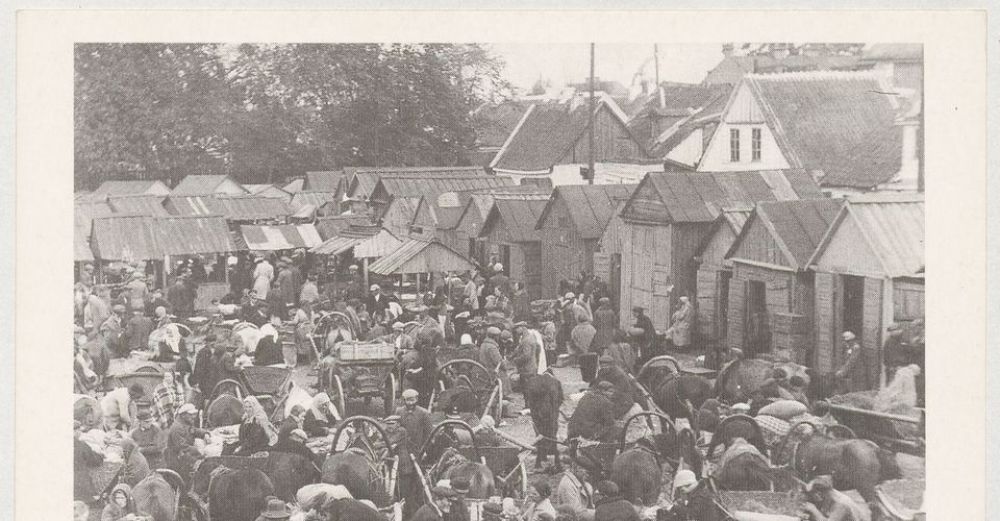- News
- Events
- Oneg Shabbat
- Collections
- Research
- Exhibitions
- Education
- Publishing Department
- Genealogy
- About the Institute
- Bookstore


Jewish settlement in Podlasie appeared in the fifteenth century. It was 1522 when Tykocin’s Duke Albert Gasztołd brought to Tykocin nine Jewish families who founded the Kahal and the cemetery. Since that time, Tykocin had become the center of the Jewish community and the largest Jewish community in Podlasie.
However, the first mention of the Jews living in Białystok estates dates back to 1658. In Białystok the privilege De non tolerandis Judaeis did not apply. Also, a city having fiscal privileges was an encouraging place for settlement.
The Jews were given by the Białystok pastor a lease of land for a construction of a synagogue. It was located on Bożnicza (now Suraski) Street and was funded in part by Hetman Branicki’s wife. The brick building was built between 1711–1718 on a rectangular plan, to which the adjacent annex was built in the late eighteenth century.
The Jews, along with other residents of the city, had to pay for services, such as site fees and taxes. Together with the Catholics they took part in night patrols protecting the city from fire and theft. However, they did not hold public offices nor did they sit on the bench. However, the president of the community participated in the selection of the city authorities.
Professions, which Białystok Jews practiced were typical for the remaining area of the Polish lands and came from the specificity of the Jewish religion. Therefore they were: butchers (ritual slaughter of cloven-hoofed animals), bakers (usually kosher bread) and craftsmen (proper sewing of clothing).
In 1807 Białystok became part of the Russian Empire as so called Belostok Oblast. Restrictive Tsarist’s laws designated area of settlement in the territory of the former Poland, which resulted in a rapid increase in the number of Jews in Białystok. At that time, in the city there were already nine synagogues and houses of prayer. Population growth had slowed down in the 1930s because of the epidemic of cholera.
The Jewish people became victims of the repressive politics of the three partitioning powers, which was based on the deprivation of the existing privileges. Białystok traders and bankers enriched themselves in trade between partitions, and high duties encouraged others to move their factories from the Polish Kingdom to Białystok. In the mid-nineteenth century, the textile industry reached dynamic development: every second weaving mill was owned by a Jewish entrepreneur.
However, national antagonisms grew and their escalation took place in 1906. On 14th to 16th June, there was a pogrom against the Jews in Białystok, which ended in killing 82 Jews.
At the turn of the century, the spatial division of the city had formed: Jewish houses and yards were located at the square and the central part of the city around Lipowa Street, Mikołajewska Street and Suraska Street. Due to the poor condition of the building, the old synagogue was demolished between 1906–1908. Between 1909–1913, in its place, the Great Synagogue was built according to a design by Samuel J. Rabinovitch. The impressive building was a combination of neo-Gothic and neo-Byzantine styles, and it was adorned with its massive dome with a diameter of 10 meters.
During World War I, Polish and Jewish residents of Białystok cooperated giving succor to the needy. They created children’s nurseries, canteens and night shelters. At this time, after the Russian military had left the city, Polish-Jewish youth unions set up a city library, which was named after a famous Jewish writer Sholem Aleichem.
The post-war stabilization did not last long in Białystok. In retaliation for losing the Battle of Warsaw, the retreating Red Army committed murder of 16 residents of Białystok: citizens of different statuses and nationalities.
The population of Jews in Białystok had a characteristic tendency to grow: from 1 890 in 1788 to 41 905 in 1897, which gave respectively 46 and 63.5 percent of the total population of the city. The first decline was recorded in 1936. The Jewish community constituted 43 percent of the population of Białystok. Several reasons for this situation can be given.
Less orthodox Jews underwent faster polonization and assimilated into Polish society. Zionist ideas made some people emigrate to Israel and others to countries in North America and South America. The recession and the global financial crisis in the 1930s caused a decrease in revenue in the textile industry and accelerated the decision to leave in search of jobs. In addition, political factors also influenced the decline: the Jewish community was divided ideologically and antagonized. Orthodox parties called for preservation of religious and national identity, while the Zionists encouraged to emigrate to Israel and form Jewish country there. It was extremely contrary to the ideas of the Bund, for whom Poland was the homeland.
Also, the relations between the Poles and the Jews became worse. On opposite sides of the fence stood National Democrats and „Żydokomuna”. At the root of the conflict lay economic reasons, not political or cultural. The radicalization was also due to the boycott of the Jewish trade and the law passed in 1938 to abolish the ritual slaughter.